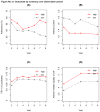The association of health literacy with adherence and outcomes in moderate-severe asthma
- PMID: 23591273
- PMCID: PMC3745278
- DOI: 10.1016/j.jaci.2013.02.014
The association of health literacy with adherence and outcomes in moderate-severe asthma
Abstract
Background: Low health literacy is associated with poor outcomes in asthma and other diseases, but the mechanisms governing this relationship are not well defined.
Objective: We sought to assess whether literacy is related to subsequent asthma self-management, measured as adherence to inhaled steroids, and asthma outcomes.
Methods: In a prospective longitudinal cohort study, numeric (Asthma Numeracy Questionnaire) and print literacy (Short Test of Functional Health Literacy in Adults) were assessed at baseline in adults with moderate or severe asthma for their impact on subsequent electronically monitored adherence and asthma outcomes (asthma control, asthma-related quality of life, and FEV1) over 26 weeks, using mixed-effects linear regression models.
Results: A total of 284 adults participated: age, 48 ± 14 years, 71% females, 70% African American, 6% Latino, mean FEV1 66% ± 19%, 86 (30%) with hospitalizations, and 148 (52%) with emergency department visits for asthma in the prior year. Mean Asthma Numeracy Questionnaire score was 2.3 ± 1.2 (range, 0-4); mean Short Test of Functional Health Literacy in Adults score was 31 ± 8 (range, 0-36). In unadjusted analyses, numeric and print literacy were associated with better adherence (P = .01 and P = .08, respectively), asthma control (P = .005 and P < .001, respectively), and quality of life (P < .001 and P < .001, respectively). After controlling for age, sex, and race/ethnicity, the associations diminished and only quality of life (numeric P = .03, print P = .006) and asthma control (print P = .005) remained significantly associated with literacy. Race/ethnicity, income, and educational attainment were correlated (P < .001).
Conclusion: While the relationship between literacy and health is complex, interventions that account for and address the literacy needs of patients may improve asthma outcomes.
Keywords: AE; ANQ; AQOL; Asthma Numeracy Questionnaire; Asthma education; Asthma-related quality of life; ED; Emergency department; Health literacy; ICS; Inhaled corticosteroid; PS; Problem-solving; S-TOFHLA; Short Test of Functional Health Literacy in Adults; adherence; adults; asthma; asthma control; asthma-related quality of life; inhaled corticosteroids; inner-city asthma; numeracy; print literacy.
Copyright © 2013 American Academy of Allergy, Asthma & Immunology. Published by Mosby, Inc. All rights reserved.
Figures


References
-
- National Assessment of Adult Literacy. Washington, DC: National Center for Education Statistics; Institute of Education Sciences; U.S. Department of Education; 2003. Available from http://nces.ed.gov/naal/
-
- Healthy People 2010: Health Communication. Washington, DC: Department of Health and Human Services; [accessed 8/17/2010, 2010]. ( http://www.healthypeople.gov/document/html/volume1/11healthcom.htm)
-
- Healthy People 2020: Health Communication and Health Information Technology. US Department of Health and Human Services; [Accessed 6/17/2011]. 2011. ( http://healthypeople.gov/2020/topicsobjectives2020/overview.aspx?topicid=18) Available from http://healthypeople.gov/2020/topicsobjectives2020/overview.aspx?topicid=18.
-
- Nielson-Bohlman L, Panzer A, Kindig D, editors. Health Literacy: A Prescription to End Confusion. Washington, D.C: National Academies Press; 2004. - PubMed
-
- Berkman ND, Sheridan SL, Donahue KE, Halpern DJ, Crotty K. Low health literacy and health outcomes: an updated systematic review. Ann Intern Med. 2011;155:97–107. - PubMed
Publication types
MeSH terms
Substances
Grants and funding
LinkOut - more resources
Full Text Sources
Other Literature Sources
Medical

